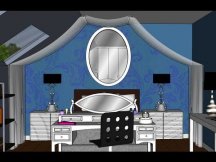How to Decorate l Shaped Bedroom?

Laughing…crying…playing…fighting. A shared sibling bedroom is a beehive of activity and needs. And that means there’s a lot for parents to tackle when creating their kids’ shared bedroom. With twice the amount (or more) of evolving personalities and necessities, it’s often a daunting task for parents to accommodate storage, space and the individual style of each child.
Here are some helpful tips to overcome common design challenges and create a happy and functional room for your young roommates.
Creating a Boy and Girl Shared Room
Designing a room for a brother and a sister doesn’t have to be challenging. In fact, it’s probably the easiest challenge to overcome when planning a shared room.
Your first step is to select an underlying color palette for the main elements of the room (walls, rug, furniture) that is gender neutral…and, if they’re old enough to chime in, that each sibling gives the thumbs up. Color combos such as white and grey, turquoise and white or a mix of primary colors work well for both boys and girls.
To complement your underlying palette, layer complementary colors and patterns on top of that. For example in a grey and white room, try accenting with yellow accessories. For patterns, lean towards stripes, chevron or solids with large geometric shape(s).
When selecting furniture, opt for furniture with clean lines and that’s non-themed (steer clear of the race car or sleeping beauty beds) and pair with neutral colored essentials such as lamps and window treatments.
The exciting part of creating a super fun bedroom for your young brood is accessorizing and customizing design elements to match their budding personalities. Select design elements that make the room feel like it belongs to both of them. Personalize accessories throughout the room such as wall art or coat hooks. Marquee lights with their names or first initial add a pop of energy and excitement to any space. Likewise, subtly add gender specific themes in one or two accessories, but keep them color coordinated. For example when accessorizing with red, try a throw pillow with a red fire engine for him, and a pillow with a red flower or heart for her. Storage that is complementary to the design scheme but specific for each gender (think charcoal for boys and yellow for girls) can also seamlessly pull a room together.
Creating a Room For Different Ages
Sometimes its not just Jeremy and Sarah that you need to accommodate, but a 3-year-old Jeremy and a 4-month-old Sarah can definitely add another layer of design anxiety.
The first thing to tackle is the furniture layout. If you have a baby, chances are you’ll be in and out of the room at night to tend to the baby. If possible, place their beds in opposite corners or walls with the crib being most accessible to the door. Obviously structural elements such as windows and heaters can dictate otherwise but your design objective is to give each child the most comfortable night’s sleep without one waking the other.
Creating a play area that both siblings can enjoy, even simultaneously, is super helpful, especially for tired mommies and daddies. Floor mats, cushions and soft larger items like a rocking horse and tents are perfect to outline the area and fun for both to play in. Place your older child’s toys in accessible storage containers, but higher than the floor so your youngest can’t easily touch it.
Related posts:

 The bagua is the feng shui energy map of your space. In order to create best feng shui energy in your living room, it is best to define the bagua of your home first…
The bagua is the feng shui energy map of your space. In order to create best feng shui energy in your living room, it is best to define the bagua of your home first… Layout for Small Rooms Strip/Basic Home Office Layout. C. Roseberry Create a Functional and Organized Workspace Tired of working in your home office because it s…
Layout for Small Rooms Strip/Basic Home Office Layout. C. Roseberry Create a Functional and Organized Workspace Tired of working in your home office because it s… This cozied-up formal dining room is wonderful for those who have a large family or group of friends and often find themselves throwing dinner parties or hosting…
This cozied-up formal dining room is wonderful for those who have a large family or group of friends and often find themselves throwing dinner parties or hosting… Will it work in the space I have planned? Our published dimensions (e.g. 93 Wx46 Dx32 H) width x depth x height in inches, will help you decide if your furniture…
Will it work in the space I have planned? Our published dimensions (e.g. 93 Wx46 Dx32 H) width x depth x height in inches, will help you decide if your furniture… Schlafzimmer: Ideen, von der Einrichtung bis zur Deko Überlegen Sie sich vor dem Einrichten die Anordnung Ihrer Schlafzimmermöbel. Ist der perfekte Standort für…
Schlafzimmer: Ideen, von der Einrichtung bis zur Deko Überlegen Sie sich vor dem Einrichten die Anordnung Ihrer Schlafzimmermöbel. Ist der perfekte Standort für…